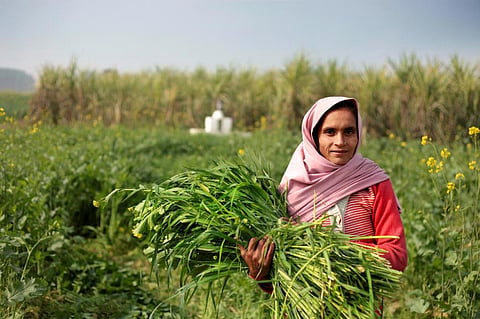

The agricultural growth rate has fallen to 3 per cent in 2021-22 from 3.3 per cent in 2020-21, according to the Economic Survey Report 2022-23 tabled in the Parliament on January 31, 2023.
The agriculture sector has been growing at an average annual growth rate of 4.6 per cent during the last six years, the report added.
But if we look at the growth trends on a year-on-year basis, the full picture that emerges is slightly different.
In three of these six years, the growth rate was reported to be below 4 per cent. And in the rest of the three years, the high growth rate was mostly due to a low base effect (base from which the growth is measured) from the previous year and a good monsoon.
A weak base means the result gets magnified because of the base year to which the current figure is being compared.
In 2016-17, for instance, the growth rate jumped to 6.8 per cent from 0.6 per cent in 2015-16, a year that saw a second successive drought, according to the survey document.
After 2016-17, the growth fell twice consecutively to 6.6 per cent in 2017-18 and then to 2.1 per cent in 2018-19, which was again a drought year. After that, it increased again to 5.5 per cent in 2019-20. In 2020-21 and 2021-22, agriculture showed a growth rate of 3.3 and 3 per cent respectively.
The Economic Survey also pointed out that the sector needs “re-orientation” in the backdrop of challenges like adverse impacts of climate change, fragmented landholdings, sub-optimal farm mechanisation, low productivity, disguised unemployment and rising input costs, among others.
But at the same time, government investment in agriculture has declined — to 4.3 per cent in 2020-21 from 5.4 per cent in 2011-12. Meanwhile, private investment is at a high of 9.3 per cent, which indicates increasing corporatisation in agriculture.
In terms of government efforts, the report talked about measures like increase in minimum support price (MSP) and the intervention of Agriculture Infrastructure Fund (AIF), a financing facility operational from the year 2020-21 to 2032-33 for the creation of post-harvest management infrastructure and community farm assets. But this was being done mostly through credit guarantee and loan support.
However, despite this, it cannot be denied that the sector has shown robust growth, absorbing the shock of the pandemic and other factors like the ongoing war in Ukraine.
India emerged a net exporter of agriculture and allied products in 2021-22, with the country’s export revenue reaching an all-time high of $50.2 billion, according to the latest Economic Survey.
The agriculture sector continued to employ the highest number of workers. The share of workers engaged in agriculture rose marginally to 46.5 per cent in 2020-21 from 45.6 per cent in 2019-20. On the other hand, the share of manufacturing declined slightly to 10.9 per cent from 11.2 per cent and that of trade, hotel and restaurants to 12.2 per cent from 13.2 per cent over the same period. The share of construction increased to 12.1 per cent from 11.6 per cent.
The year-on-year rate of growth of nominal wage rates was also highest in the agriculture sector — 5.1 per cent for men and 7.5 per cent for women, during April-November 2022.
In non-agricultural activities, the growth of nominal wage rates was 4.7 per cent for men and 3.7 per cent for women during the same period. However, growth in real rural wages has been negative due to elevated inflation.
The survey also highlighted another important trend of increasing contribution of the livestock sector. The livestock sector grew at a compound annual growth rate of 7.9 per cent during 2014-15 to 2020- 21 (at constant prices).
Though the crop sector is still the major contributor to agriculture gross value added (GVA) at constant prices, its contribution has been on a decreasing trend – from 65.4 per cent in 2011-12 to 55.1 per cent in 2020-21.
The contribution of the livestock sector, meanwhile, to total agriculture GVA has increased to 30.1 per cent from 20 per cent during the corresponding period.